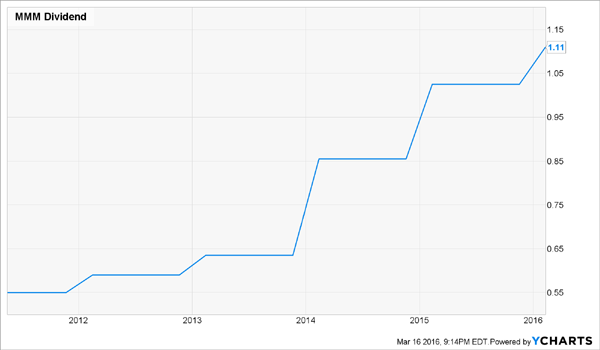Billionaire investor George Soros said it best: “Good investing is boring.”
Two great examples: dividend reinvestment plans (DRIPs)—an automatic way of building wealth that most investors ignore—and the S&P 500 Dividend Aristocrats.
Let’s take the second one first. Many of the 50 companies on the Dividend Aristocrats list peddle everyday staples like tape, telephone service and over-the-counter drugs—products that are about as humdrum as you’ll find.
These are household names like Colgate-Palmolive (CL), Kimberley-Clark (KMB), and Clorox (CLX). (I’ll give you the names of my three favorite Dividend Aristocrats in a minute.)
[ad#Google Adsense 336×280-IA]But these companies have a big edge over the flashy wearable tech and biotech stocks investors usually go gaga for: they pay steady dividends.
Not only that, they’ve all hiked their payouts for 25 straight years.
Even in the 2008 meltdown, when dividends were being slashed left and right—and many “exciting” stocks saw their share prices shredded—investors who held onto the S&P 500 Dividend Aristocrats quietly pocketed rising payouts.
The Lazy Investor’s Way to Profit Like Buffett
To say investors who ignore dividends are missing out is a massive understatement. Consider a recent study from Ned Davis Research that delved into stock returns from January 1972 through December 2014.
The conclusion? Dividend payers are good… but dividend-growers are great. Stocks that paid a growing dividend delivered double-digit returns and outpaced steady dividend-payers by one-third, to boot:
 But if that’s not enough to convince you that dividend-growers are the secret to long-term wealth, just ask Warren Buffett.
But if that’s not enough to convince you that dividend-growers are the secret to long-term wealth, just ask Warren Buffett.
His holding company, Berkshire Hathaway (BRK.A), holds a healthy sprinkling of Dividend Aristocrats in its stock portfolio, including Coca-Cola (KO), AT&T (T), Johnson & Johnson (JNJ)—more on JNJ below—Procter & Gamble (PG) and Wal-Mart Stores (WMT).
But to really cash in on these steady dividend-growers, you need two things: a long holding period and compounding—you need to start reinvesting those payouts as early as possible. That’s where DRIPs come in.
How to Get Rich, DRIP by DRIP
DRIPs let you use your cash dividends to purchase additional shares in a company (and even fractions of shares; more on this in a moment) without paying commissions. That means your cash buys its full weight of shares.
Under a DRIP, the company simply reinvests your dividends instead of cutting you a check. That leads to a very happy cycle: as you buy more shares, you generate higher dividend payments—which you use to buy more shares. And because of the periodic nature of the investment, you get more shares when the stock is cheap and fewer when it’s pricey.
That can turn a middling long-term return into a fantastic one. Here’s how the S&P 500 has performed over the past decade with dividends reinvested vs. price only:
 Traditionally, you’d have to go through a company or its transfer agent to set up a DRIP, but these days it’s easier than ever: you can enroll in the DRIP programs of stocks you own through a discount broker.
Traditionally, you’d have to go through a company or its transfer agent to set up a DRIP, but these days it’s easier than ever: you can enroll in the DRIP programs of stocks you own through a discount broker.
3 Great Dividend Aristocrats With DRIPs
3M Co. (MMM) is a solid DRIP stock for many reasons, including one of the world’s most diverse businesses: the industrial giant sells 19,180 products in the US alone. That keeps it from having to rely on one or two big sellers.
Then there’s its dividend history: 3M yields 2.7%, and it has paid a dividend for 98 straight years. It easily makes the Dividend Aristocrats list thanks to the hikes it’s handed out over the last 57 years.
And if you think these are drowsy, penny-a-year affairs, think again. 3M has doubled its payout in the last five years alone:
 And there’s plenty more to come, thanks to the company’s modest 53% payout ratio (or the percentage of earnings it hands back to investors as dividends) and the fact that it pours a lot of cash into R&D, setting it up for more breakthrough products—and higher profits.
And there’s plenty more to come, thanks to the company’s modest 53% payout ratio (or the percentage of earnings it hands back to investors as dividends) and the fact that it pours a lot of cash into R&D, setting it up for more breakthrough products—and higher profits.
Johnson & Johnson (JNJ) is another high-dividend, low-volatility pick that’s perfect for DRIP investing. That’s partly a function of its broad business. Like 3M, its products are everywhere.
Aside from consumer goods like Neutrogena skin cream and Tylenol (19% of 2015 revenue), JNJ makes pharmaceuticals (45%) and medical devices (36%).
On the dividend front, JNJ easily earns a spot among the Dividend Aristocrats, with 53 straight years of payout hikes. The shares yield 2.8%, well ahead of the average S&P 500 stock. And its safe payout ratio of 54.8% means you can look forward to bigger DRIP purchases in the years ahead.
Finally, Hormel Foods (HRL) yields just 1.3%, but it’s returned a cool 535% to investors over the past decade, including a 314% hike to its dividend over the same period.
The specialty food maker has a cart full of top-quality brands, including 30 that hold down the No. 1 or No. 2 share of their respective markets. Hormel has beaten analyst earnings estimates for each of the last four quarters and has boosted its free cash flow by 169% since 2011.
Management projects 14–18% earnings per share growth in 2016. That—along with Hormel’s low 32% payout ratio—should keep its dividend hikes coming, making your dividend reinvestments even meatier.
— Brett Owens
Sponsored Link: These three Dividend Aristocrats are great buys now, whether you enroll in their DRIPs or not, but I like three other stocks even more. They throw off yields investors in Hormel, 3M and Johnson & Johnson can only dream about. I’m talking about payouts of 6.9%, 7.3% and 8.9%.
All three are cashing in on the biggest demographic shift in US history: the aging of America’s 77 million baby boomers. And no matter what the Fed, China or the next US president does, it won’t put a dent in that trend.
These rock-solid companies provide direct care to an older population that’s exploding. Consider that 10,000 Americans turn 65 every day—and will continue to do so for the next 15 years.
And all three are growing their dividends at a rapid clip. In fact, my favorite of the three doesn’t raise its dividend annually—it hikes it every single quarter!
 The best part? Most investors haven’t picked up on these three stocks yet. That means you can collect yields north of 7% and position yourself to grab 15–20% upside in the next 12 months as other investors pile into these reliable dividend-payers.
The best part? Most investors haven’t picked up on these three stocks yet. That means you can collect yields north of 7% and position yourself to grab 15–20% upside in the next 12 months as other investors pile into these reliable dividend-payers.
That’s why I’m urging my subscribers to lock in these juicy dividends today, while they’re still cheap. Click here to get more information all three of these dream investments and discover how we’re playing this megatrend now.
Source: Contrarian Outlook
